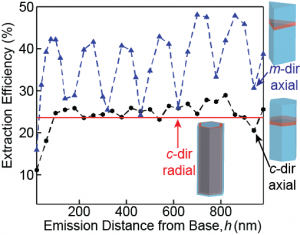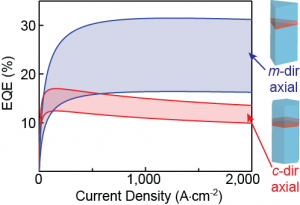Efficiency Comparison of m- and c-directional GaN Nanowire-based LEDs on Si
- Category: Materials, Nanotechnology, Optics & Photonics
- Tags: jordan chesin, silvija gradecak
III-nitride nanowire-based light-emitting diodes (LEDs) are promising alternatives to thin-film LEDs for solid-state lighting[1]. Facile strain relaxation in nanowires allows epitaxial growth on mismatched substrates, such as silicon[2]. We compare the external quantum efficiency of III-nitride LEDs based on axial and radial nanowire heterostructures on silicon substrates, considering many important aspects of the design, including polarization anisotropy common in III-nitrides[3] and the effects of orientation with respect to surface recombination and the radiative efficiency of the quantum well. Extraction efficiency was calculated using finite-difference time domain photonic simulations; the internal quantum efficiency (IQE) was estimated based on the relative rates of non-radiative, radiative and Auger recombination. We first note that there are different regimes of wave-guiding, where nanowires can weakly guide a single-mode, strongly confine that mode or guide multiple modes. We focus on single-mode nanowires in which the light is well confined within the nanowire. In such nanowires we find that the placement of the quantum well (QW) where coupling to the fundamental mode is maximized also results in the highest light extraction efficiency. We find that m-directional axial heterostructures have the highest extraction efficiency, due to the strong polarization anisotropy of III-nitrides, which orients emission so as to couple strongly with the fundamental mode (Figure 1). Furthermore, despite higher surface recombination rates, m-directional axial heterostructures display similar or higher IQE than c-directional axial heterostructures due to lower radiative recombination efficiency in polar c-plane QWs caused by the quantum-confined Stark effect. The modeled IQE and the simulated extraction efficiencies are combined to find a range of expected external quantum efficiencies (EQEs), which reveal that m-directional axial heterostructures have EQEs up to three times that of c-directional axial heterostructures at high current densities (Figure 2). This work provides important guidelines for the design of future III-nitride nanowire-based LEDs with high overall efficiencies.
- Figure 1: Simulated extraction efficiency as a function of the QW placement for m-directional and c-directional axial heterostructures, with the solid line indicating the extraction efficiency for a c-directional radial heterostructure with the QW placed at 0.9 the distance from the center to the surface.
- Figure 2: Estimated EQE ranges for m- and c-directional axial heterostructures obtained by combining IQE modeling (via the A-B-C model) and extraction efficiency simulations from three-dimensional finite-difference time-domain photonic simulations.
- F. Qian, S. Gradečak, Y. Li, C.-Y. Wen, and C. M. Lieber, “Core/multishell nanowire heterostructures as multicolor, high-efficiency light-emitting diodes,” Nano Letters, vol. 5, pp. 2287-2291, 2005. [↩]
- Y. B. Tang, Z. H. Chen, H. S. Song, C. S. Lee, H. T. Cong, H. M. Cheng, W. J. Zhang, I. Bello, and S. T. Lee, “Vertically aligned p-type single-crystalline GaN nanorod arrays on n-type Si for heterojunction photovoltaic cells,” Nano Letters, vol. 8, no. 12, pp. 4191-95, 2008. [↩]
- N. F. Gardner, J. C. Kim, J. J. Wierer, Y. C. Shen, and M. R. Krames, “Polarization anisotropy in the electroluminescence of m-plane InGaN–GaN multiple-quantum-well light-emitting diodes,” Applied Physics Letters, vol. 86, p. 111101, 2005. [↩]

